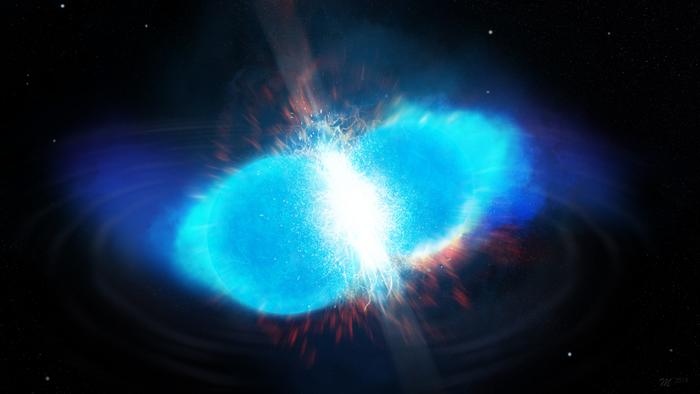New scientific models are suggesting that nuclear fission may play a key role in the creation of heavy elements in the universe—which, if true, would be the first example of nuclear fission occurring in space.
The research, described in a paper published Thursday in the peer-reviewed journal Science, found that the levels of certain elements found in the mergers of some stars fit the theory that they could be the byproducts of fission producing even heavier elements.
“People have thought fission was happening in the cosmos, but to date, no one has been able to prove it,” Matthew Mumpower, a theoretical physicist at Los Alamos National Laboratory and co-author of the paper, said in a press release.
Nuclear fission is the process in which a neutron slams into a larger atom and splits it, releasing energy and additional neutrons, not to be confused with nuclear fusion, in which super-heated atoms smash together to combine to a single, heavier atom, giving off a massive amount of leftover energy in the process.
Nuclear fusion is more than just common in space—it’s the heart powering every single star. A star is born when balls of spinning gas become massive enough and hot enough that atoms heated to more than 10 million degrees Celsius can overcome the electric repulsion between them and collide.
But while nuclear fission has been harnessed on Earth for use in nuclear power reactors, where the heat from nuclear fission boils water to create steam to turn a turbine for power, and in nuclear weapons, it has only ever been theorized to occur in space.
This study found evidence for nuclear fission in space through an investigation of something called the rapid neutron-capture process, or r-process.
Chemical elements heavier than iron are known as “heavy elements,” which are created by the r-process. This process occurs during the collision of neutron stars, or sometimes while a star going supernova, and boils down to a seed nuclei getting struck with so many neutrons at once that it builds up into a heavy element before the components have a chance to radioactively decay into lighter elements.
But while scientists have had an idea of how r-process works and what it does for decades, our understanding of how some of the heavier heavy elements are formed is much fuzzier.
Researchers in this study looked at element abundances in a sample of stars where r-process had occurred, in order to get a better idea of what is occurring during this process.
They found that the amount of elements including ruthenium, rhodium, palladium and silver, which are all considered lighter elements, correlated with the abundances of heavier elements, with the amount of one group increasing when the corresponding element of the other group went up.
The team used modelling to test what could explain this pattern, and only found one answer that made sense: nuclear fission.
“The only plausible way this can arise among different stars is if there is a consistent process operating during the formation of the heavy elements,” Mumpower said.
“This is incredibly profound and is the first evidence of fission operating in the cosmos, confirming a theory we proposed several years ago. As we’ve acquired more observations, the cosmos is saying hey, there’s a signature here, and it can only come from fission.”
Mumpower, who developed the fission models which guided the observational findings, first predicted that the r-process could involve the distribution of fission fragments back in 2020. Later that year, Nicole Vassh, a co-author on this new paper, led a study that suggested the co-production of lighter elements with heavier elements during r-process, a concept which provided the framework for how these theories could be tested for.
Lead author on the December study, Ian Roederer, built on the previous research by looking at observational data from 42 stars to find the correlations that had been predicted earlier.
“The correlation is very robust in r-process enhanced stars where we have sufficient data. Every time nature produces an atom of silver, it’s also producing heavier rare earth nuclei in proportion. The composition of these element groups are in lock step,” Mumpower said. “We have shown that only one mechanism can be responsible — fission — and people have been racking brains about this since the 1950s.”
The research was funded through the Laboratory Directed Research and Development program at the Los Alamos National Laboratory (LANL), a federally funded lab with a mission statement focused on solving national security challenges. According to the U.S. Department of Energy’s website, the lab performs research “in support of the nuclear weapons stockpile,” as well as theoretical and applied research across disciplines including environmental science, physics and health, among others.
THE BIRTH OF A HEAVY ELEMENT
One of the other findings of this research is that more elements could exist that are even heavier than the ones we are currently aware of.
The research points to the existence of chemical elements with an atomic mass higher than 260, the study suggests. Atomic mass is the number of protons plus neutrons within an element, and while a handful of elements have been identified above that threshold for atomic mass, this new research suggests elements above this atomic mass could be regularly produced in r-process events.




